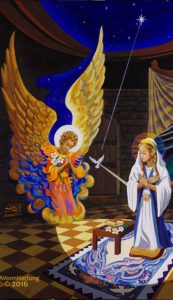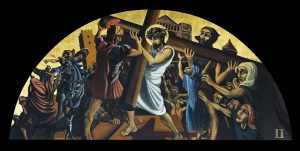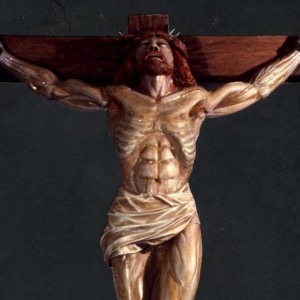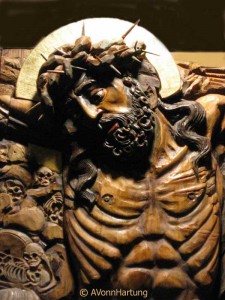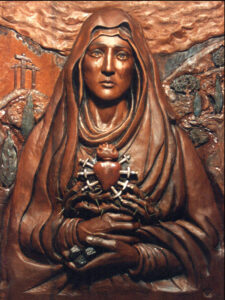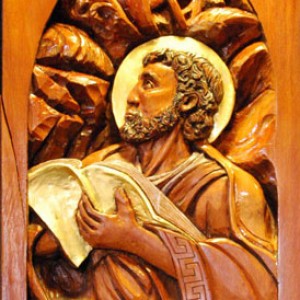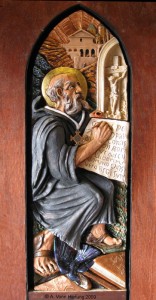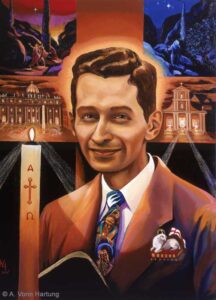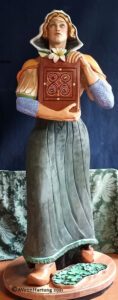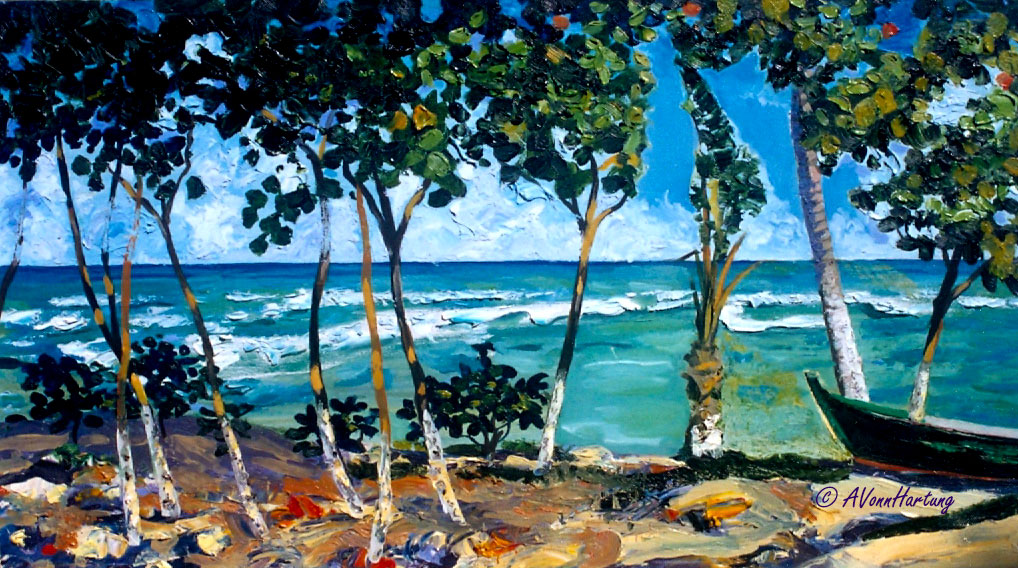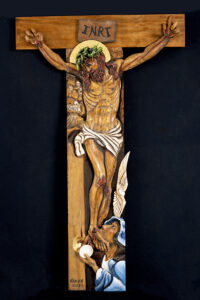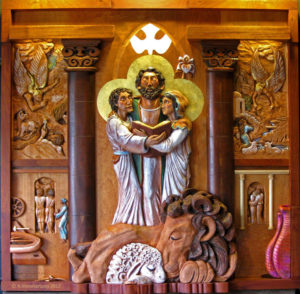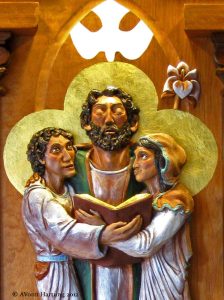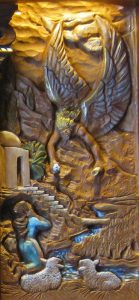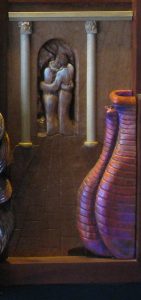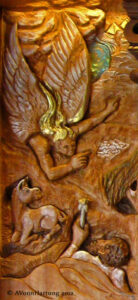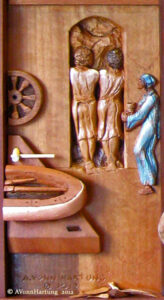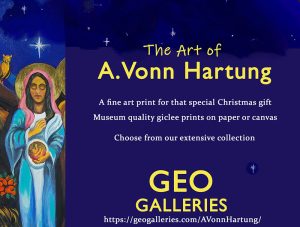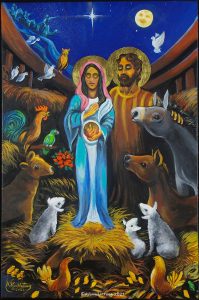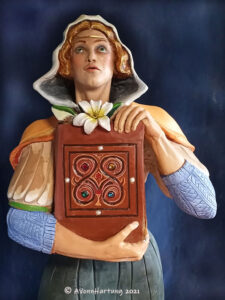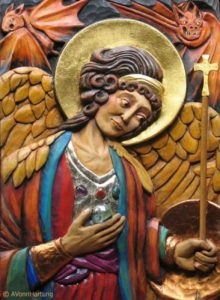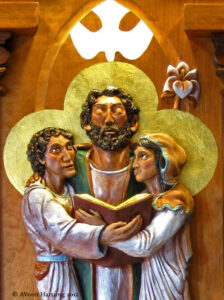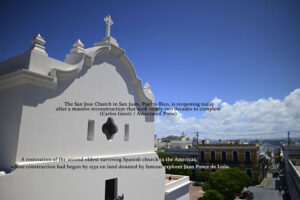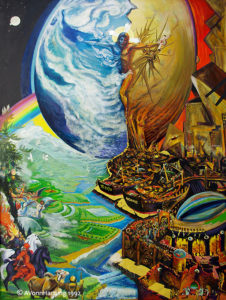Vea un video de estas Estaciones de la Cruz, acompañadas de música sacra
Ver video La Pasión de nuestro Señor
Read in English
La razón para el uso de Arte Sacro en la Iglesia es hacer visible lo que es invisible, para llevarnos a un estado más elevado de conciencia y la conexión con Dios y sus Santos, que podamos compartir más plenamente en Su Gloria y Amor por nosotros, para que podamos seguir adelante y hacer su voluntad.
Los lugares sagrados de la vida, muerte y resurrección de Jesús siempre han sido venerados: los primeros peregrinos volvieron sobre el Vía Crucis. Así fue que los peregrinos trajeron de Tierra Santa la idea de recrear esos lugares y eventos sagrados para compartir con los fieles de sus iglesias de origen.
Se dice que San Francisco de Asís inició la práctica del Vía Crucis. Después se extendió por toda Italia y Europa. Era su práctica de reproducir de forma realista los acontecimientos de la vida de nuestro Señor y obras (un ejemplo, es su instalación reportado de establo y pesebre con animales y personas vivos en conmemoración del nacimiento de Jesús).
De manera similar concebí estas Estaciones de la Cruz para darle inmediatez a la Pasión de Nuestro Señor.
Cada uno mide 4 pies x 8 pies. Esto se debe al tamaño cavernoso y la sencillez interior de la nave de la iglesia, Santa Rosa de Lima, en el pueblo de Guaynabo, Puerto Rico. La intimidad se logró mediante el uso de la gente local como modelos y costumbres de modo que los fieles pudieran identificarse mejor con las pruebas que Nuestro Señor y Salvador sufrió y murió por Su Amor por nosotros.
Imágenes contemplativas para Semana Santa
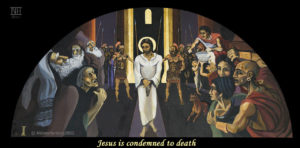
Aquí vemos a Jesús, centrado, rodeada por muchos, pero completamente solo, únicamente los ingresados desde el status quo en ambos lados (aunque vemos Flavia, esposa de Pilato y tal vez Nicodemo que representan un pequeño grupo de simpatizantes internos).
En medio de una habitación llena de gente, Él es una figura solitaria. Todas las señales apuntan a Él, las columnas, el pasillo central y todos los que gesticulan lo señalan en acusación. ¡Él es el indicado! ¡La causa de todos sus problemas, indignación y odio! Él debe morir!
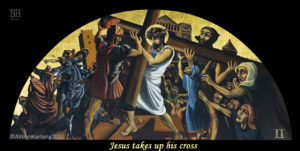
Este es el momento temido entre muchos momentos temidos. ¡No temer tal Prueba no sería completamente humano! Este es el precio de hablar la verdad al poder; de hacer milagros en público donde los fariseos pudieran ver; de proclamar el Reino de Dios a los humildes de corazón, los oprimidos, sino también a los líderes orgullosos y peligrosas del templo …
Sí, ESTE es su Día, el día que planearon y esperaron durante tanto tiempo y planearon que Pilato, el Prelado Romano, los matara. Es la gran novedad que vuela alrededor de Jerusalén, el juicio y la pena de muerte ha sido emitida para el hijo Jesús, el carpintero de quien llama a sí mismo Hijo de Dios.
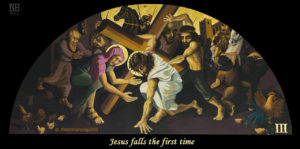
Jesús cae. La Cruz es extremadamente pesada, tan pesada que tiene que arrastrarla. Está agotado por falta de sueño; Han pasado más de 30 horas desde la última vez que durmió y ha sufrido repetidas palizas brutales y torturas. El día es caluroso y el camino está abarrotado de espectadores, la mayoría de los cuales lo abuchean y quizás incluso lo hacen tropezar.
En medio de este espectáculo escandaloso se apresura un anciano lleno de compasión, no preocupado por su propia seguridad, como también la santa mujer que se apresura a ayudarlo a él también, y un hombre entre la multitud, un extraño que da un paso adelante para estabilizar la Cruz. .
Aquí también vemos a la gente amable y buena a lo largo del Camino. Incluso las criaturas de la Creación se acercan como testigos de la Pasión de nuestro Señor.
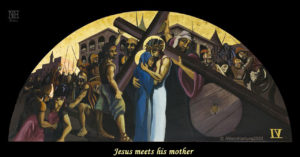
Aquí VEMOS por primera vez la preocupación del Centurión que está a cargo del escuadrón de la muerte. Él está FIJADO en el hombre de Cirene que sostiene la Cruz para Jesús mientras abraza a Su Madre (en una verdadera manera de cariño puertorriqueña. Pero ¿qué madre no seguiría y se acercaría a su hijo en tal ocasión?)
¿Qué es este Centurion permitiendo a suceder? ¿Qué le está permitiendo volverse menos soldado y más humano, solo otro hombre, solo otro hijo?
Él está comenzando a VER lo que los creyentes sabemos: ¡que la esencia de nuestro Dios es el Amor! Esta Verdad VISTA por él en tiempo real, lo desarma. Él ve la compasión y el afecto sin miedo, sino también en la acción y la preocupación de este hombre fuera de la ciudad, este extranjero arriesgando su vida para este momento tierno y tranquilo dentro de esta tormenta de la violencia …
¡Es el comienzo de un evento que cambia la vida del Centurión y la vida del mundo! Es la esencia de todas las historias de Conversión; el momento en que el incrédulo a través del desconcierto comienza a dudar de su propia suposición. Comienza a CREER !!!
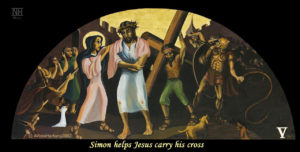
Aquí vemos los primeros resultados de este ablandamiento, esta Conversión del Centurión. Le permite a Simón (debe haberle preguntado su nombre y quizás así quedó registrado) a llevar la Cruz. Ahora la santa mujer ha regresado con una manta, el color rosa, símbolo del Amor Materno.
¡Todo el miedo se ha ido! Este es un verdadero signo de Gran Fe: ¡falta de miedo! ¡El soldado no está acostumbrado a esto! Niños, sí, los puede entender sin saber las consecuencias de desafiar a la Autoridad de Roma. ¿Pero estos adultos? ¿Esas mujeres? ¿Que está pasando aqui?
Incluso sus hombres están actuando fuera de carácter cuando este Nazareno rompe rango y abraza a su madre. Y un espectador, una mujer se desmaya! Su propio hombre y soldado también rompe rango y la toma en sus brazos con compasión.
Está sucediendo algo que no se comprende fácilmente y está comenzando a afectarlo a él y a sus hombres.
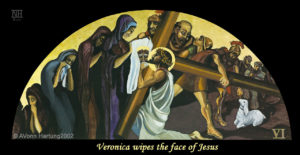
Otra mujer se adelanta entre la multitud. Es Verónica, una amiga de María y de la familia. Ella enjuga el rostro de Jesús. Verónica representa la fe perfecta, serena y sin ningún rastro de miedo o ansiedad. Con toda calma limpia la sangre y el sudor del rostro de nuestro Señor con su velo en el que aparece la imagen perfecta de Dios. El hombre bajo ve este milagro y le dice al hombre a su lado que no puede verlo.
El Centurión está hipnotizado por la Fe de Verónica, que está simbolizada por las etapas de la creencia progresiva que la ensombrecen: desde la desesperación total y la incredulidad más lejana, hasta la duda y una sensación de impotencia y, finalmente, hasta la timidez vacilante junto al acto lleno de fe, compasión y valor de Verónica.
Este es el momento en que, para el Centurión, la confusión y la duda se están desvaneciendo. Él está viendo la creencia y está aturdido por lo que ve! Hay un Poder que él siente que es más fuerte que el suyo y lo que representa, la “Roma Imperial”. Y está llegando a través de estos niños sin poder, los ancianos, las mujeres y este criminal, golpeado y condenado, que está luchando para llegar a donde es que va a morir!
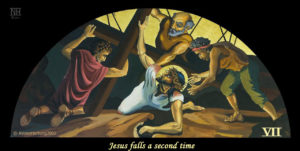
Esta composición es simple y escasa. Tiene el propósito de mostrar una de las etapas de aceptación de la inevitabilidad de la entrega y la muerte. La sensación de aislamiento y desesperanza que se produce cuando el cuerpo físico envía el mensaje al cerebro que la resistencia se está desvaneciendo hasta el punto de no retorno, y que la muerte está ganando a las fuerzas naturales de la vida.
Jesús no se da por vencido y está siendo ayudado. Pero el escaso número de ayudantes se prestan a este sentimiento de impotencia y aislamiento. Lo más probable es que Jesús esté entrando en otro nivel de conciencia en el que confía más en la fuerza de Su Padre que en Su propia capacidad física para seguir adelante. Pero su voluntad es fuerte como se representa por medio de su mano derecha en su cruz.
¡Él no parece, de ninguna manera significativa, estar apoyando la Cruz sino luchando por no soltarla! ¡Él y la Cruz se han convertido en uno! Él está haciendo la voluntad de su Padre. Él completará qué es lo que le ha sido enviada a lograr.
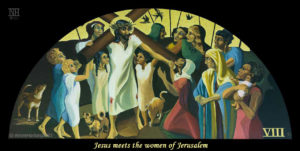
Al acercarse a las mujeres de Jerusalén que lloran, se compadece de ellas. Pero en lugar de consolarlas de manera sentimental estándar, les habla a ellas y a nosotros como un profeta.
En este terrible momento Jesús no está pensando sólo en sí mismo, de su sufrimiento, de su drama. Le preocupa el drama de la humanidad, de todos los seres humanos. Él ve proféticamente otro drama humano abriéndose frente a sus ojos. Y estas mujeres que se lamentaban tienen que cambiar sus vidas.
¿Cuántas veces había repetido esto mientras predicaba en la tierra de Galilea o Judea? Cuántas veces había gritado sobre viento y tempestad, sobre desierto y llanuras: “Ha llegado el momento. El reino de Dios está cerca. ¡Arrepiéntanse y crean las buenas nuevas! ” (Mc 1,15)
Volvía a decirles, y a través de ellos a los que le seguían con una sonrisa en sus caras: “se tomará el reino de Dios lejos de vosotros y será dado a un pueblo que produzca sus frutos” (Mt 21:43), porque “El sonido de lamentos se oye desde Sion: ‘¡Cuán arruinados estamos! ¡Cuán grande es nuestra vergüenza! Debemos dejar nuestra tierra porque nuestras casas están en ruinas ”(Jer 9, 19)”.
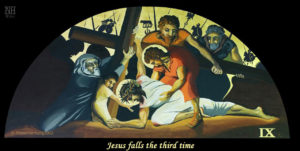
En esta estación intento mostrar el completo agotamiento de Jesús. Literalmente está siendo sostenido por el joven fuerte que lo monta a horcajadas. Simbólicamente Él está en el nivel de fuerza de un niño pequeño, sin embargo, todavía se aferra a su Cruz en lugar de sostenerla.
El símbolo del anciano es otro indicio de la falta de fuerza que siente Jesús. Sin embargo, tanto el niño como el anciano muestran determinación y fe para seguir adelante que Jesús mismo siente, aunque está completamente agotado.
Los símbolos en el fondo son los emblemas de los poderes del mundo, las del imperio romano de su tiempo. Pero más allá de eso, simbolizan todo poder depredador Imperial y la riqueza adquirida a través de la injusticia y el poder militar.
La Cruz está siempre presente y simboliza el Sacrificio que debe hacerse para redimir los Pecados del mundo.
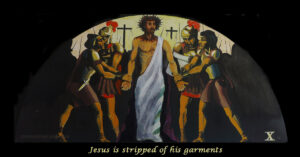
Una vez más, vemos a Jesús el centro de atención. De todas las humillaciones que se le han dado, esta es, en cierto modo, la mayor. Él es despojado de una manera que él se siente desnudo. Pero en su desnudez, y a través de cualquier indignidad que está sintiendo, Dios está mostrando la belleza y la fuerza del cuerpo humano, y la belleza física de su hijo. Esto lo quería retratar, ya que tantas veces se muestra a Jesús como afeminado.
Era un trabajador de gran alcance, un carpintero en el sentido de que él hizo muchas tareas con su padre José con madera pesada que se requería para construir casas, medios de transporte, así como arados y otros equipos y herramientas agrícolas. Su musculatura da fe de que era un trabajador, un obrero que atendía las necesidades de sus vecinos.
Él se encuentra en gran dignidad como el rey que es, no como el criminal condenado y acobardado que a sus torturadores les gustaría que fuera.
Aquí vemos la conclusión de la conversión del Centurión parado a la derecha de Jesús quitándose la túnica. Él mira hacia arriba a Dios, dándose cuenta de su complicidad en la tortura y ejecución de este hombre inocente y aparentemente divina. Será este Centurion quien oiremos hablar las palabras de Marcos 15:39 al ver a Jesús respira su último aliento en la cruz ( “Verdaderamente este hombre era Hijo de Dios!”)
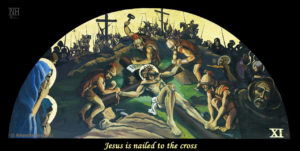
Aquí asistimos al espectáculo lleno en la escena de la Crucifixión, el Gran Evento de Jerusalén, donde tantos han llegado para la celebración de la Pascua.
Lo que un gran entretenimiento para muchos, lo terrible conmoción y tristeza para los seguidores de nuestro Señor. Los militares están cumpliendo eficientemente su trabajo en una unidad perfectamente coordinada en su administración en el arte romano de la crucifixión. Tan precisa fue esta macabra forma de tortura y muerte, que en la forma en que colgaron los cuerpos en la cruz pudieron determinar cuánto tardaría la víctima en morir.
Vemos a nuestro Centurión sosteniendo el pie de Jesús mientras mira a la Madre de Jesús y a la otra María a su lado. ¡Él NO hará ninguno de los clavos! A la izquierda de Jesús y también en primer plano se asoma el espíritu fantasmal de Judas Iscariote, un retrato de los condenados.
Así vemos los dos extremos del bien y el mal que enmarcan la composición de un lado a otro, con la figura de Jesús centrada; las barras transversales de Su cruz tanto como la balanza equilibrada del juicio.
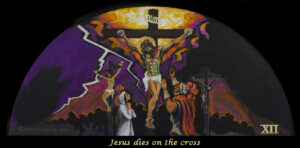
En el momento en que Jesús muere, el velo del templo se rompe y un rayo divide el cielo. El Buen Ladrón está como protegido de esta terrible luz de la verdad de que este era el hijo de Dios condenado falsamente, y que el criminal condenado que se atrevió a creer en Él estará hoy en el paraíso.
Jesús fue atravesado con una lanza en el corazón del cual brotó sangre y agua para que se cumpliera la profecía: “Ninguno de sus huesos será quebrantado” (Juan 19:36), ya que se acercaba la Pascua. Ya que Jesús solo había colgado de la cruz durante unas seis horas en su insoportable agonía que debe haber parecido una vida.
La agonía de la crucifixión se puede entender mejor leyendo el libro Un Médico en el Calvario, del cirujano francés Pierre Barbet.
En el caso de Jesús, habría tenido que empujar hacia arriba en los clavos que le cortaron los pies para poder respirar, ya que el peso de su cuerpo le abriría los pulmones y se asfixiaría si no se esforzara insoportablemente para respirar una dolorosa respiración a la vez. Podríamos contemplar esto en oración, imaginando el dolor al inhalar y exhalar en contemplación.
Se dice que Jesús sudaba sangre al final, que por falta de oxígeno y espasmos musculares, su sistema capilar se rompió.
Crucifixión de verdad es la muerte más terriblemente doloroso que se pueda imaginar!
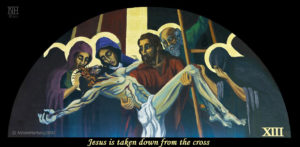
Esta estación se imagina Nicodemo, Juan, Madre María y sus santas compañeras bajar el precioso cuerpo de nuestro Señor desde la cruz.
La cruz se convierte en una reliquia sagrada. Por lo tanto, visto como una luz dorada vertical. Esta luz de la gracia se esparce horizontalmente a Sus santos, y en Pentecostés se esparcirá por todo el mundo a Sus creyentes como el aliento de Dios en el Espíritu Santo.
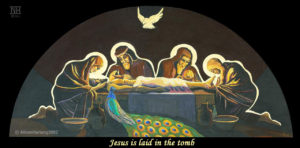
Una vez más, imaginado como luz santa en la tumba oscurecida, vemos a la madre de Jesús, amigos y compañeros creyentes ungiendo y envolviendo Su cuerpo sagrado mientras Su espíritu flota arriba antes de descender al “sheol“.
La escena es tranquila y serena, al igual que la muerte después de tan horribles pruebas de violencia. Es la luz de la Fe y la Esperanza en La Resurrección que borra la oscuridad y la muerte y se VE aquí en el pavo real, Símbolo del Paraíso.
Vea un video de estas Estaciones de la Cruz, acompañadas de música
Ver video La Pasión de nuestro Señor
Las pinturas encargo del Mons. Antonio “Tito” José Vázquez
